Program Highlights
During its 40+ year history, CCM has developed core competencies in a number of composites science and engineering areas, including liquid molding, sensing and control, re-engineering, interphase science, composites from renewable sources, thermoplastic processing, joining, and cost modeling. Utilizing 52,000 square feet of state-of-the-art facilities and equipment valued at over $25M, CCM develops models and simulations in a “virtual manufacturing” environment for process optimization and tool design, leading to improved quality, affordability, and innovative new composite manufacturing processes. Our unique manufacturing science laboratory provides facilities for synthesis of new materials, chemical and mechanical characterization from nano-scale to large-scale structures, computation, design, and re-engineering and manufacturing work cells on existing and next-generation processes that are ready for transition to our sponsors.
DARPA TuFF: Tailored Universal Feedstock for Forming
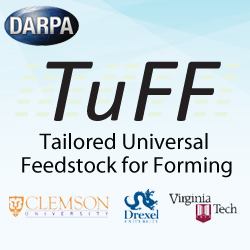 |
The Defense Advanced Research Projects Agency (DARPA) has awarded the University of Delaware Center for Composite Materials (UD-CCM) a $14.9M three-year cooperative agreement for the Tailorable Feedstock and Forming (TFF) Program.
The objective of this program is to develop a novel low-cost carbon-fiber composite feedstock and manufacturing process. The new material, called TuFF (tailorable universal feedstock for forming), may potentially revolutionize the use of composite materials world-wide, as a cost-effective replacement for small metal parts meeting aerospace performance requirements. |
NASA University Leadership Initiative (ULI)-Composite Manufacturing Technologies
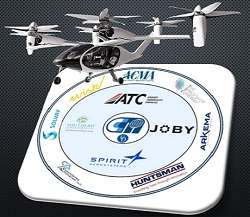 |
Using newly developed TuFF material, NASA-ULI awards UD-CCM $5.9M to address technology barriers in manufacturing of complex geometry composite parts for Urban Air Mobility (UAM) and commercial air platforms, meeting aerospace performance at automotive-like production rates, and to transition technology to our industrial partner followed by the US industrial base. |
U.S. Army CCDC Army Research Laboratory:
Composites Research, Engineering and Advanced Manufacturing Technology (CREATE) Program
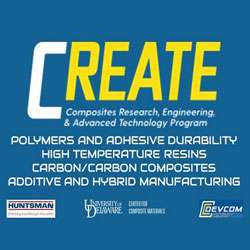 |
UD-CCM has received $13.6M to date for the Composites Research, Engineering and Advanced Manufacturing Technology (CREATE) Program Cooperative Agreement. This is a 5-year program to create new composite materials, processing and manufacturing methods and/or use existing materials and manufacturing methods in novel ways to achieve new levels of lightweight, affordable, durable and multi-functional composites. |
MEDE: Materials in Extreme Dynamic Environments
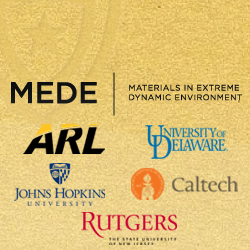 |
CCM is a lead consortium member of the Materials in Extreme Dynamic Environments (MEDE) Collaborative Research Alliance consortium, which was established in 2012 by the Army Research Laboratory (ARL), the principle collaborating government agency. CCM joins experts from across the country in a collaboration that includes engineers from national laboratories, private industry, and three other universities — Johns Hopkins, Caltech, and Rutgers. The consortium investigates what happens to a broad array of protective materials — including polymers, composites, metals, and ceramics — to understand high strain rate response when subjected to intense impact, when a large amount of energy enters a small space in a very short period of time. Polyethylene and S-glass/epoxy have been selected as the model polymer system and model composite system, respectively, for the program. The research involves both multi-scale modeling and experimental work ranging from molecular dynamics to the continuum length scales. The overall goal is to develop a materials-by-design approach to improve material performance in extreme dynamic environments. This program has been reviewed and renewed through 2022. |
Department of Energy Ultra-Light Composite Doors
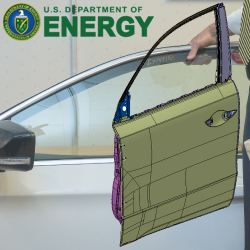 |
Researchers at University of Delaware Center for Composite Materials (UD-CCM) have formed Industry and University Partnerships in two programs recently funded to design, manufacture, and demonstrate an ultra-light hybrid composite door through a Department of Energy program aimed at advancing fuel-efficient vehicle technologies.
UD-CCM is part of the Clemson University led team where researchers will use carbon-fiber-reinforced thermoplastic composites to fabricate a driver’s side front-door assembly for a large original equipment manufacturer (OEM). The goal is to reduce the door’s weight by 42.5 percent as automakers work to meet U.S. corporate average fuel economy (CAFE) standards. Fleets of vehicles are supposed to average 54.5 miles per gallon by 2025. |
Thermoplastic Composite B-Pillar
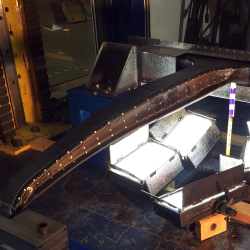 |
UD-CCM in partnership with NCMS, NHTSA and BMW investigated thermoplastic carbon fiber reinforced materials for vehicle sideframe structures. The proposed B-pillar was designed to meet structural and crash safety requirements (e.g., FMVSS 214 barrier) using thermoplastic composites which offers significant advantages (e.g., recycling, joining, >60% elongation leading to improved ductility and energy absorption) compared to thermoset with the potential for improved crash performance. |
NASA Z-2 Spacesuit Prototype
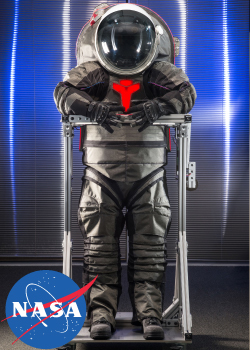 |
The University of Delaware Center for Composite Materials is part of a team led by ILC Dover that received a $4.4 million contract from NASA to design, manufacture, and test a next-generation spacesuit. UD-CCM was able to help push spacesuit performance to the next level by optimizing design and manufacturing while reducing defects found in earlier composite parts. This was a challenge, partly because NASA wanted a flight-quality test article that would be safe for human mobility trials and astronaut training in a vacuum chamber. “Project funding and timeline allowed for only one chance at fabricating the suit components, which was to be done under supervision of government quality auditors and required rigorous process documentation and control,” says Dan Molligan, assistant director for application development at UD/CCM/ATTL. Molligan notes that, “ATTL is an off-site ITAR restricted facility which has an infrastructure very unlike other universities; it has rigorous SOP, SMP, and quality standards which conforms to commercial industry protocol.” |
Rapid Prototyping of Advanced Passive Dynamic Ankle-Foot Orthoses (PD-AFO) Designs for Wounded Warriors
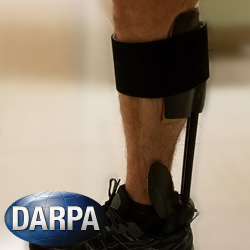 |
Awarded in 2012 by the Defense Advanced Research Projects Agency (DARPA), the goal of this program is to develop rapid automated manufacturing technologies for composite Passive Dynamic Ankle-Foot Orthoses (PD-AFOs) that can demonstrate order of magnitude reductions in cycle time, while improving performance characteristics, individual customizability and affordability. The general technical approach is to evaluate a number of rapid composite manufacturing concepts associated with selected PD-AFO materials and designs, with the development of process and cost models for each concept. Combining process/cost models with design and analysis tools enables true concurrent engineering, such that optimal composite PD-AFO designs will be created that are both manufacturable and affordable. Trade studies will be performed using these virtual tools, to identify a manufacturing concept that can meet the design specifications, cycle time requirements, and retain sufficient flexibility for individual customization. |
TARDEC Composite Structures Initiative (CSI)
 |
The initial Composite Structures Initiative program was established with U.S. Army Tank Automotive Research, Development and Engineering Center in 2007 and a new 3-year program was recently awarded in the Fall of 2013. The new CSI program centers on performance based application of research technologies in the areas of new materials, engineering and modeling methods, and novel processing techniques for composites for tactical and combat vehicles. In addition to demonstrating these technologies through application to existing and new vehicle platforms, testing and validation is carried out to further understand the performance of these new materials and designs. Close collaboration with industry ensure that the technologies and capabilities are practical, and can be elevated to a Technology Readiness Level appropriate for rapid insertion into military platforms. |
DARPA Warrior Web Program -Integrated Textile Reinforced Upper Body Support System (iTRUSS)
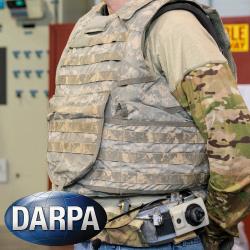 |
The Defense Advanced Research Projects Agency (DARPA) Warrior Web program’s objective is the development warfighter-wearable and quasi-active suit systems to improve warfighter effectiveness and reduce injury. Awarded in 2012, CCM has developed an Integrated Textile Reinforced Upper body Support System (iTRUSS) that reduces loads on the lumbar-spine region and provides alternative load paths to the hips while providing active control of posture to prevent injury. The technical approach involves the development of a self-reacting system (combination of tension and compression elements) that is integrated into an upper body garment (such as an undershirt) with load transfer into a belt around the hips. Loading at the shoulders is alleviated by load distribution through low-profile shoulder pads. This approach reduces body compression under heavy loads, reduces loads in lumbar/spine region, control posture, improves breathing efficiency and ultimately mitigate fatigue and overuse injury. |
Composites Research, Engineering and Advanced Technology (CREATE) Program
 |
A 5-year Cooperative Agreement with the Army Research Laboratory – Weapons and Materials Research Directorate (ARL–WMRD), CREATE is a a comprehensive interdisciplinary program to create new composite materials and processing methods and/or use existing materials and manufacturing methods in novel ways to achieve new levels of lightweight, affordable and multifunctional performance for Soldier Systems. This program uses multi-scale and multi-physics modeling and simulation to predict processing microstructure performance relationships and use our extensive experimental facilities for validation. It includes personnel exchange and facilities sharing that focuses on maturing promising research, establishing generic capabilities and rapidly transitioning new capabilities for lightening combat, tactical and air manned and unmanned vehicles and individual soldier systems for the Future Force. |







